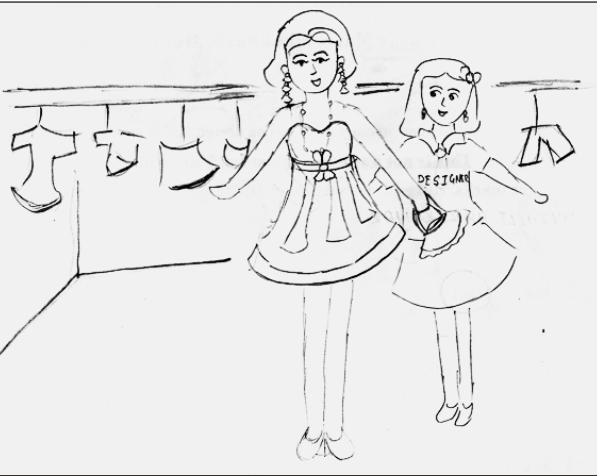Students’ images of designers
Investigation into Indian elementary and middle school students’ images of designers using the ‘Draw a designer at work’ test was conducted with 511 students from Classes 5 to 9 from a school located in Mumbai. Findings indicate that Indian elementary and middle school students, with no experience in D&T, perceive designers mostly as fashion/dress designers or artists. Designing is associated more with arts and less with engineering and technology.

These results are consistent with our earlier work on Indian middle school students’ ideas about design and designers using written responses, where students demonstrated an incomplete understanding of design and designing. In the present study students, mostly older ones depicted gender and professional stereotypes: design as engineering or building shown more often by boys was mostly associated with male designers. Insights from the study have implications for curriculum development at the school level in India.
Publications
Ara, F., Chunawala, S. and Natarajan, C. (2013). Investigating Indian elementary and middle school student’s images of designers. Design and Technology Education: An International Journal 18 (2), 50-65.
Ara, F., Chunawala, S and Natarajan C. (2011). A Study Investigating Indian Middle School Students Ideas of Design and Designers. Design and Technology Education: An International Journal, 16.3, 62-73.
Designing with and without make
A debate in D&T education has revolved around the importance of freedom to design without the constraint of having to make versus the benefits of making. A study of Indian middle school students was undertaken to see the differences between the two situations. Two different sets of students from Class 7, about 14 to 25 in each set, were given the brief to solve the same real-world design problem. One set was told that they would have to make the artefact they has designed, while the other did not have to make their solutions work. Students’ design solutions were compared in terms of elements of creativity and their design decision skills. Students unconstrained with making showed more evidences of creativity and risk taking. However, students in a design-with-make activity had and used the greater number of opportunities to make design decisions that were conceptual, technical, constructional, aesthetic or marketing. The making activity also allowed students to recreate the entire design process and develop skills in designing. It is proposed that both the activities need to be used in design education to foster students’ creativity and design decision skills.
Publication:
Ara, F., Chunawala, S., & Natarajan, C. (2013). Students as designers and makers: Indian middle school students’ creative solutions to design-without-make and design-with-make activities, Paper presented at the Designing Design Education for India Conference, 13-15 March, 2013, Pune India.
Exploring unfamiliar artefacts
This study explores the strategies employed by Indian middle-school students working in groups to identify three unfamiliar artefacts. The activity described in the study was aimed at sensitising students to the close link between form and function and to bring a certain amount of uncertainty in the tasks before the actual design task. It was part of a larger study that explored students’ ideas about design and designers before and after they engaged in design related activities. Twenty two students of class 7 worked in six groups of three or four members and the entire exchange was video-recorded. The verbatim transcription of the conversation within the groups and the actions and gestures executed by students were categorised. Groups came up with various accidental functions for the three artefacts and only three groups were successful in identifying the intended functions of all three artefacts. All groups utilised similar strategies while trying to identify the artefacts however they differed in the frequency of use of these strategies. Cognitive strategies included active discussions within the group and handling strategies involved manipulation of the artefacts by the group members. Groups which were less interactive, less critical of others ideas and less defensive of their own ideas were unsuccessful in identifying the intended functions of the artefacts.
Publication:
Ara, F., Natarajan, C. and Chunawala, S. (2009). A Study Exploring the Strategies Utilised by Indian Middle-School Students in Identifying Unfamiliar Artefacts. Design and Technology Education: An International Journal, 14.3, 47-57.
All of the above projects formed part of a doctoral thesis:
Ara, F. (2013). Investigating students’, teachers’ and designers’ ideas about design and developing design activities for Indian middle school students. Doctoral Thesis. Mumbai: HBCSE, TIFR Deemed University.